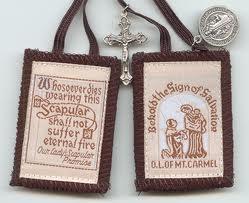The term scapular (from Latin scapulae, "shoulders") as used today refers to two specific, yet related, Christian Sacramentals, namely the monastic and devotional scapulars, although both forms may simply be referred to as "scapular".
The "monastic scapular" appeared first, perhaps as early as the 7th century in the Order of Saint Benedict. It is a somewhat large length of cloth suspended both front and back from the shoulders of the wearer, often reaching to the knees. It may vary in shape, color, size and style. Monastic scapulars originated as aprons worn by medieval monks, and were later extended to habits for members of religious organizations, orders or confraternities. Monastic scapulars now form part of the habit of monks and nuns in many Christian orders.
The "devotional scapular" is a much smaller item and evolved from the monastic scapular. These may also be worn by individuals who are not members of a monastic order and the Roman Catholic Church considers them sacramentals. The devotional scapular typically consists of two small (usually rectangular) pieces of cloth, wood or laminated paper, a few inches in size which may bear religious images or text. These are joined by two bands of cloth and the wearer places one square on the chest, rests the bands one on each shoulder and lets the second square drop down the back.
In many cases, both forms of the scapular come with a set of promises for the faithful who wear them. Some of the promises are rooted in tradition, and others have been formally approved by religious leaders. For instance, for Roman Catholics, as for some other sacramentals, over the centuries several popes have approved specific indulgences for scapulars.
Though each scapular has its own particular qualifications and usage, the Church has set down certain rules that pertain to all types, be they monastic or devotional.
A scapular associated with a confraternity must be invested by an ordained representative of that group. A scapular associated with a mystery or devotion may simply be blessed by a priest and given to the wearer.
To receive the benefits or indulgences granted the scapular generally must be worn constantly. It may be placed aside for a time but, during that period, the wearer does not receive the scapular's benefits. Should the wearer take up the wearing of it again, the benefits are again conferred.
A devotional scapular must be in good repair with both bands intact. Multiple scapulae may be worn on the same bands, but the bands must be the color of those prescribed by the scapular with the most preeminence, and that scapular must be foremost with the others behind in order of precedence. If a scapular becomes damaged to the point where it cannot be in good repair, it must be replaced. However, it is not necessary for the wearer to be reinvested as it is the devotion of the wearer, not the object itself, that confers the benefit of the scapular.


